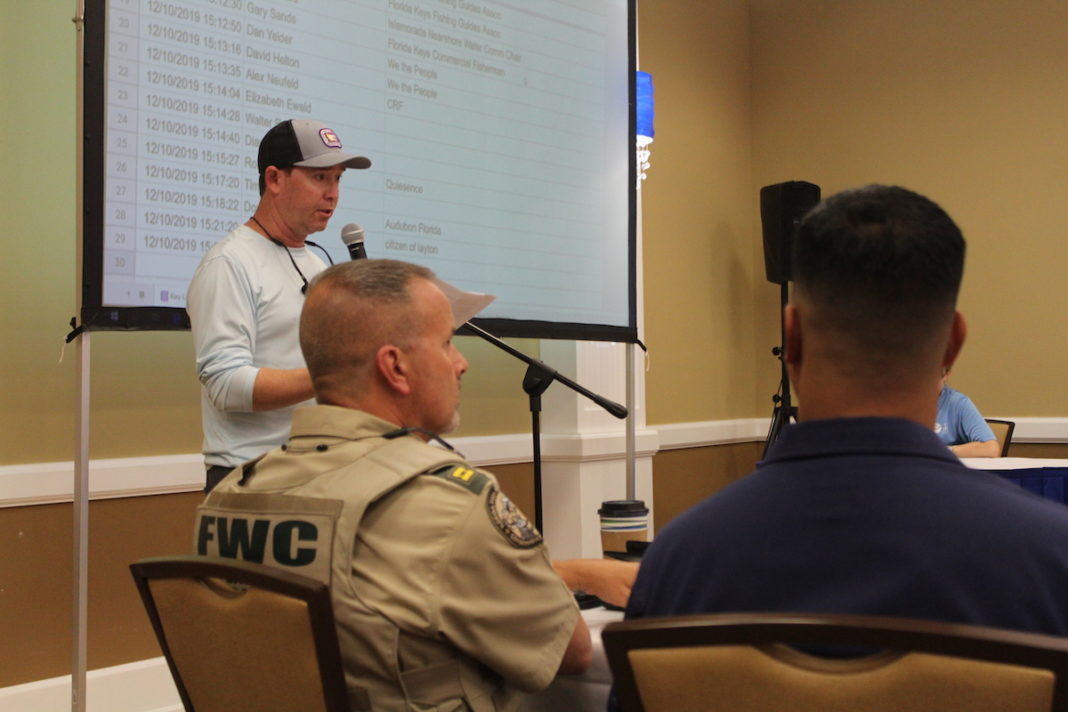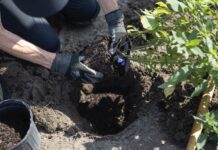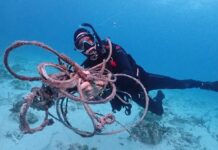Inside the Islander Conference Center on Dec. 10, Florida Keys National Marine Sanctuary Superintendent Sarah Fangman and advisory council members listened intently as captains, conservation stakeholders and homeowners shared passionate testimony over the state of the waters and opinions on the proposed Restoration Blueprint.
“A lot of things you talk about doing would put me out of business,” said Capt. Brandon Jimenez, who runs the Sea Spirit out of Key Largo. “There has to be some happy medium for us.”
“Not acting is not an option,” said Jessica Levy, reef restoration program manager for Coral Restoration Foundation. “Good, strong management helps build resilience to pressures, and it helps our environment be resilient to bigger challenges that are much more difficult to address.”
Public comment on proposed changes to marine zones, regulations and management is approaching the Jan. 31, 2020 cutoff. The Restoration Blueprint was unveiled to the public in August with four alternatives.
Since then, meetings have been held up and down the islands with information on certain zones and proposals. Feedback has also been gathered via oral and written comment.
So far, a little over 600 comments on the plan have been submitted to regulations.gov. During the Sanctuary Advisory Council’s meeting Dec. 10, members passed a resolution strongly encouraging the public to voice their feedback.
Per sanctuary officials, a high number of comments submitted support the status quo, alternative 1 in the Restoration Blueprint. However, they say many identify other specific actions related to water quality, enforcement and education.
Capt. Spencer Slate, of Slate Scuba Adventures in Tavernier, emphasized water quality and enforcement in his comments to Fangman and the advisory council. Slate, a former SAC member, urged the public to write letters to legislators in Tallahassee and Gov. Ron DeSantis.
“Everyone in this room, write 50 letters to everyone (in the) legislature and DeSantis and bitch about water quality coming out of Lake O,” he said. “All we want to do out here will come to nothing if we do not fight water quality all the way to Tallahassee.”
Fisherman Tim Klein attested to the poor water quality as he spoke to officials. He said he’s been talking about water quality for many years and numerous meetings.
“Where I fish in shallow water, it’s disgusting,” he said. “It’s brown water with a peculiar moss that’s brown and green. When I throw a cast net in a spot, it’s loaded with green moss.”
Islamorada resident Charles Causey said people generally don’t like change. But without a healthy resource, he said, people won’t come and visit.
“We got a sanctuary that’s deteriorating. We have twice as many fishermen, four times as many boaters than 30 years ago,” he said. “There’s a huge amount of pressure on our resources. In order to have some sort of future, we gotta protect it. “
Several relayed their objection to a no-anchoring proposal to an existing, 132-square-mile management area in Key Largo adjacent to other protected areas such as John Pennekamp Coral Reef State Park and Dagny Johnson Key Largo Hammock Botanical State Park. This zone encompasses a network of habitat types, including seagrass beds, shallow hardbottom and coral reefs. The zone includes areas that prohibit spearfishing, marine life collecting and harvest of lobster, as well as recreational and commercial fishing.
Key Largo resident Steven Leonard said the no-anchor proposal is “not fair to residents” and puts a huge strain on bait and tackle shops. He proposed making the zone off-limits during mini lobster season. He also recommended a course to teach boaters how to anchor in the area.
Comment periods typically run for 30 to 60 days. But due to the complex nature of the document and the desire to inform and provide opportunity to as many stakeholders as possible, the Restoration Blueprint public comment period was expanded to 165 days.
NOAA officials say they will carefully review and consider all official comments. While NOAA has a preferred alternative, elements of all alternatives will be considered and, based on public input, scientific data and subsequent changes to resource conditions, a single proposal will be released for additional public comment. While the Restoration Blueprint, in its current state, includes concepts for consideration, the refined proposal will include definitive language.
For sanctuary management to succeed, according to Keys Marine Lab deputy director Cindy Lewis, it should protect 20% to 30% of the habitats and ecosystems as no-take areas. As it stands today, special preservation areas constitute less than 1% of the entire Florida Keys National Marine Sanctuary. Lewis expressed her support for the expansion of SPAs into deeper waters.
“These are America’s reefs and it’s our responsibility to be good stewards of them,” she said.



























